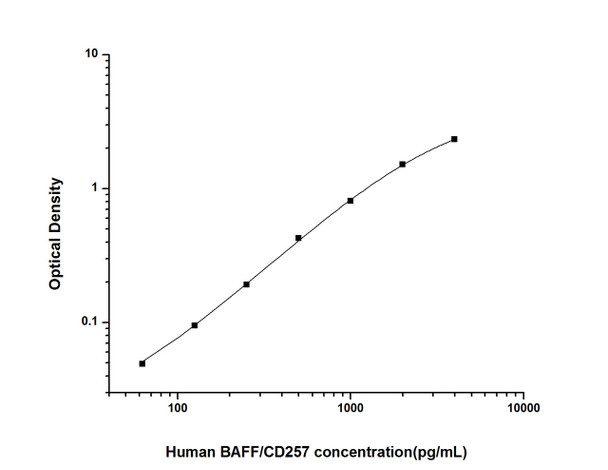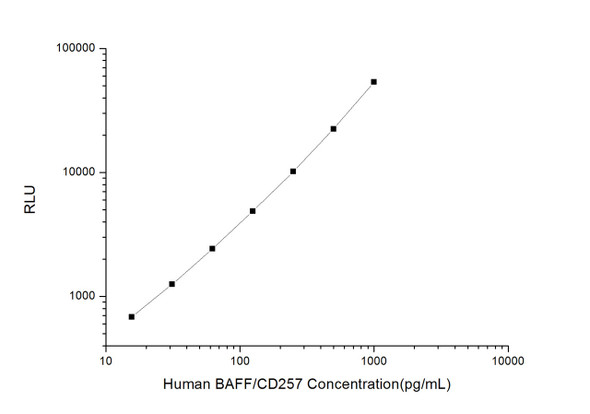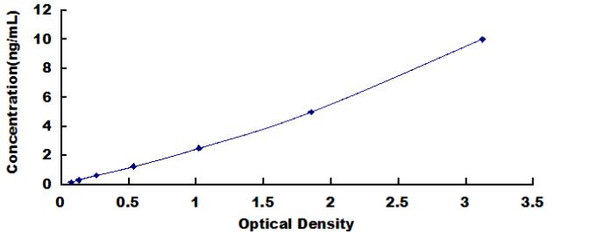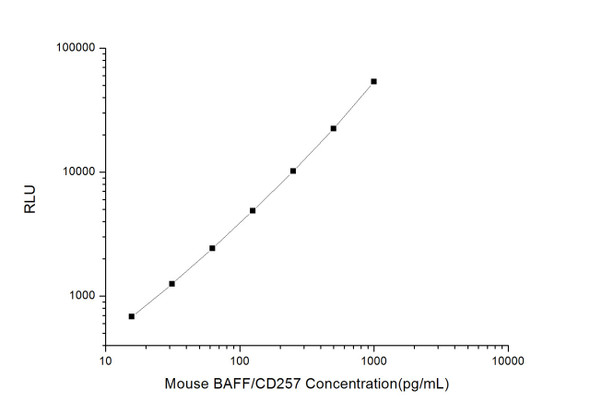Human Immunology ELISA Kits 1
Human BAFF/CD257 (B-Cell Activating Factor) ELISA Kit (HUES01296)
- SKU:
- HUES01296
- Product Type:
- ELISA Kit
- Size:
- 96 Assays
- Uniprot:
- Q9Y275
- Sensitivity:
- 37.5pg/mL
- Range:
- 62.5-4000pg/mL
- ELISA Type:
- Sandwich
- Synonyms:
- TNFSF13B, BLYS, TALL1, THANK, TNFSF20, ZTNF4
- Reactivity:
- Human
- Sample Type:
- Serum, plasma and other biological fluids
- Research Area:
- Immunology
Description
| Assay type: | Sandwich |
| Format: | 96T |
| Assay time: | 4.5h |
| Reactivity: | Human |
| Detection Method: | Colormetric |
| Detection Range: | 62.50-4000 pg/mL |
| Sensitivity: | 37.50 pg/mL |
| Sample Volume Required Per Well: | 100µL |
| Sample Type: | Serum, plasma and other biological fluids |
| Specificity: | This kit recognizes Human BAFF/CD257 in samples. No significant cross-reactivity or interference between Human BAFF/CD257 and analogues was observed. |
This ELISA kit uses Sandwich-ELISA as the method. The micro ELISA plate provided in this kit has been pre-coated with an antibody specific to Human BAFF/CD257. Standards or samples are added to the appropriate micro ELISA plate wells and combined with the specific antibody. Then a biotinylated detection antibody specific for Human BAFF/CD257 and Avidin-Horseradish Peroxidase (HRP) conjugate are added to each micro plate well successively and incubated. Free components are washed away. The substrate solution is added to each well. Only those wells that contain Human BAFF/CD257, biotinylated detection antibody and Avidin-HRP conjugate will appear blue in color. The enzyme-substrate reaction is terminated by adding Stop Solution and the color turns yellow. The optical density (OD) is measured spectrophotometrically at a wavelength of 450 nm ± 2 nm. The OD value is proportional to the concentration of Human BAFF/CD257. The concentration of Human BAFF/CD257 in samples can be calculated by comparing the OD of the samples to the standard curve.
| UniProt Protein Function: | BAFF: Cytokine that binds to TNFRSF13B/TACI and TNFRSF17/BCMA. TNFSF13/APRIL binds to the same 2 receptors. Together, they form a 2 ligands -2 receptors pathway involved in the stimulation of B- and T-cell function and the regulation of humoral immunity. A third B-cell specific BAFF-receptor (BAFFR/BR3) promotes the survival of mature B-cells and the B-cell response. Belongs to the tumor necrosis factor family. 2 isoforms of the human protein are produced by alternative splicing. |
| UniProt Protein Details: | Protein type:Apoptosis; Membrane protein, integral; Cytokine; Cell cycle regulation Chromosomal Location of Human Ortholog: 13q32-q34 Cellular Component: extracellular space; perinuclear region of cytoplasm; cytoplasm; plasma membrane; integral to membrane Molecular Function:protein binding; cytokine activity; tumor necrosis factor receptor binding; receptor binding Biological Process: cell proliferation; B cell costimulation; B cell homeostasis; immunoglobulin secretion; T cell costimulation; positive regulation of cell proliferation; positive regulation of germinal center formation; positive regulation of B cell proliferation; immune response; positive regulation of T cell proliferation; signal transduction |
| NCBI Summary: | The protein encoded by this gene is a cytokine that belongs to the tumor necrosis factor (TNF) ligand family. This cytokine is a ligand for receptors TNFRSF13B/TACI, TNFRSF17/BCMA, and TNFRSF13C/BAFFR. This cytokine is expressed in B cell lineage cells, and acts as a potent B cell activator. It has been also shown to play an important role in the proliferation and differentiation of B cells. Alternatively spliced transcript variants encoding distinct isoforms have been identified. [provided by RefSeq, Mar 2011] |
| UniProt Code: | Q9Y275 |
| NCBI GenInfo Identifier: | 13124573 |
| NCBI Gene ID: | 10673 |
| NCBI Accession: | Q9Y275. 1 |
| UniProt Secondary Accession: | Q9Y275,Q6FHD6, Q7Z5J2, E0ADT7, |
| UniProt Related Accession: | Q9Y275 |
| Molecular Weight: | 17,578 Da |
| NCBI Full Name: | Tumor necrosis factor ligand superfamily member 13B |
| NCBI Synonym Full Names: | tumor necrosis factor (ligand) superfamily, member 13b |
| NCBI Official Symbol: | TNFSF13B |
| NCBI Official Synonym Symbols: | DTL; BAFF; BLYS; CD257; TALL1; THANK; ZTNF4; TALL-1; TNFSF20 |
| NCBI Protein Information: | tumor necrosis factor ligand superfamily member 13B; delta BAFF; Delta4 BAFF; B-lymphocyte stimulator; B-cell-activating factor; ApoL related ligand TALL-1; TNF homolog that activates apoptosis; dendritic cell-derived TNF-like molecule; tumor necrosis factor-like protein ZTNF4; TNF and ApoL-related leukocyte expressed ligand 1; tumor necrosis factor (ligand) superfamily, member 20 |
| UniProt Protein Name: | Tumor necrosis factor ligand superfamily member 13B |
| UniProt Synonym Protein Names: | B lymphocyte stimulator; BLyS; B-cell-activating factor; BAFF; Dendritic cell-derived TNF-like molecule; TNF- and APOL-related leukocyte expressed ligand 1; TALL-1; CD_antigen: CD257Cleaved into the following 2 chains:Tumor necrosis factor ligand superfamily member 13b, membrane form; Tumor necrosis factor ligand superfamily member 13b, soluble form |
| UniProt Gene Name: | TNFSF13B |
| UniProt Entry Name: | TN13B_HUMAN |
As the OD values of the standard curve may vary according to the conditions of the actual assay performance (e. g. operator, pipetting technique, washing technique or temperature effects), the operator should establish a standard curve for each test. Typical standard curve and data is provided below for reference only.
| Concentration (pg/mL) | O.D | Average | Corrected |
| 4000 | 2.368 2.412 | 2.39 | 2.333 |
| 2000 | 1.55 1.586 | 1.568 | 1.511 |
| 1000 | 0.866 0.86 | 0.863 | 0.806 |
| 500 | 0.482 0.484 | 0.483 | 0.426 |
| 250 | 0.256 0.24 | 0.248 | 0.191 |
| 125 | 0.155 0.149 | 0.152 | 0.095 |
| 62.50 | 0.103 0.109 | 0.106 | 0.049 |
| 0 | 0.048 0.066 | 0.057 | -- |
Precision
Intra-assay Precision (Precision within an assay): 3 samples with low, mid range and high level Human BAFF/CD257 were tested 20 times on one plate, respectively.
Inter-assay Precision (Precision between assays): 3 samples with low, mid range and high level Human BAFF/CD257 were tested on 3 different plates, 20 replicates in each plate.
| Intra-assay Precision | Inter-assay Precision | |||||
| Sample | 1 | 2 | 3 | 1 | 2 | 3 |
| n | 20 | 20 | 20 | 20 | 20 | 20 |
| Mean (pg/mL) | 185.79 | 600.16 | 1343.28 | 173.82 | 543.69 | 1425.24 |
| Standard deviation | 11.65 | 35.47 | 54.13 | 11.94 | 28.71 | 45.04 |
| C V (%) | 6.27 | 5.91 | 4.03 | 6.87 | 5.28 | 3.16 |
Recovery
The recovery of Human BAFF/CD257 spiked at three different levels in samples throughout the range of the assay was evaluated in various matrices.
| Sample Type | Range (%) | Average Recovery (%) |
| Serum (n=5) | 87-101 | 94 |
| EDTA plasma (n=5) | 86-100 | 91 |
| Cell culture media (n=5) | 90-105 | 96 |
Linearity
Samples were spiked with high concentrations of Human BAFF/CD257 and diluted with Reference Standard & Sample Diluent to produce samples with values within the range of the assay.
| Serum (n=5) | EDTA plasma (n=5) | Cell culture media (n=5) | ||
| 1:2 | Range (%) | 92-105 | 95-108 | 91-103 |
| Average (%) | 100 | 101 | 97 | |
| 1:4 | Range (%) | 91-108 | 86-99 | 87-102 |
| Average (%) | 99 | 93 | 94 | |
| 1:8 | Range (%) | 86-99 | 85-97 | 85-100 |
| Average (%) | 93 | 90 | 91 | |
| 1:16 | Range (%) | 91-106 | 86-100 | 85-96 |
| Average (%) | 98 | 92 | 90 |
An unopened kit can be stored at 4°C for 1 month. If the kit is not used within 1 month, store the items separately according to the following conditions once the kit is received.
| Item | Specifications | Storage |
| Micro ELISA Plate(Dismountable) | 8 wells ×12 strips | -20°C, 6 months |
| Reference Standard | 2 vials | |
| Concentrated Biotinylated Detection Ab (100×) | 1 vial, 120 µL | |
| Concentrated HRP Conjugate (100×) | 1 vial, 120 µL | -20°C(shading light), 6 months |
| Reference Standard & Sample Diluent | 1 vial, 20 mL | 4°C, 6 months |
| Biotinylated Detection Ab Diluent | 1 vial, 14 mL | |
| HRP Conjugate Diluent | 1 vial, 14 mL | |
| Concentrated Wash Buffer (25×) | 1 vial, 30 mL | |
| Substrate Reagent | 1 vial, 10 mL | 4°C(shading light) |
| Stop Solution | 1 vial, 10 mL | 4°C |
| Plate Sealer | 5 pieces | |
| Product Description | 1 copy | |
| Certificate of Analysis | 1 copy |
- Set standard, test sample and control (zero) wells on the pre-coated plate and record theirpositions. It is recommended to measure each standard and sample in duplicate. Note: addall solutions to the bottom of the plate wells while avoiding contact with the well walls. Ensuresolutions do not foam when adding to the wells.
- Aliquot 100 µL of standard solutions into the standard wells.
- Add 100 µL of Sample / Standard dilution buffer into the control (zero) well.
- Add 100 µL of properly diluted sample (serum, plasma, tissue homogenates and otherbiological fluids) into test sample wells.
- Cover the plate with the sealer provided in the kit and incubate for 90 min at 37 °C.
- Aspirate the liquid from each well, do not wash. Immediately add 100 µL of BiotinylatedDetection Ab working solution to each well. Cover the plate with a plate seal and gently mix. Incubate for 1 hour at 37 °C.
- Aspirate or decant the solution from the plate and add 350 µL of wash buffer to each welland incubate for 1-2 minutes at room temperature. Aspirate the solution from each well andclap the plate on absorbent filter paper to dry. Repeat this process 3 times. Note: a microplatewasher can be used in this step and other wash steps.
- Add 100 µL of HRP Conjugate working solution to each well. Cover with a plate seal andincubate for 30 min at 37 °C.
- Aspirate or decant the solution from each well. Repeat the wash process for five times asconducted in step 7.
- Add 90 µL of Substrate Reagent to each well. Cover with a new plate seal and incubate forapproximately 15 min at 37 °C. Protect the plate from light. Note: the reaction time can beshortened or extended according to the actual color change, but not by more than 30min.
- Add 50 µL of Stop Solution to each well. Note: Adding the stop solution should be done inthe same order as the substrate solution.
- Determine the optical density (OD value) of each well immediately with a microplate readerset at 450 nm.






